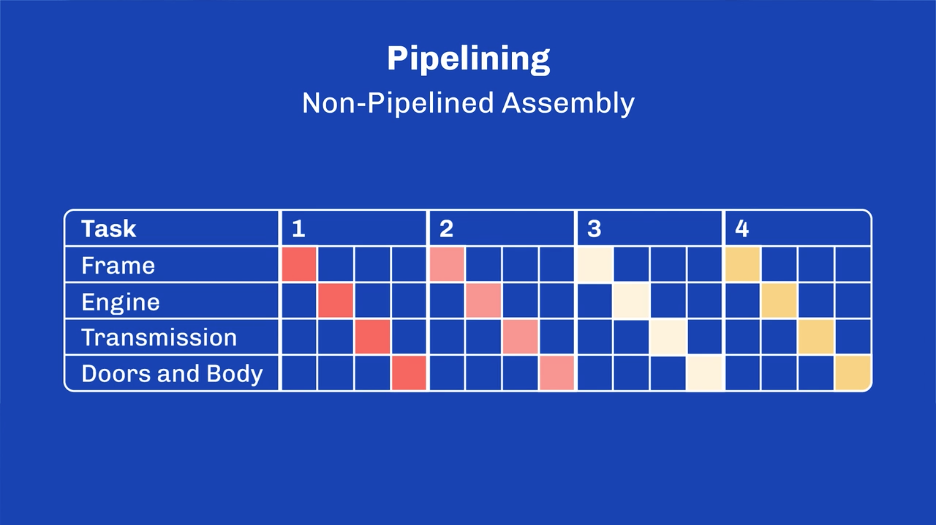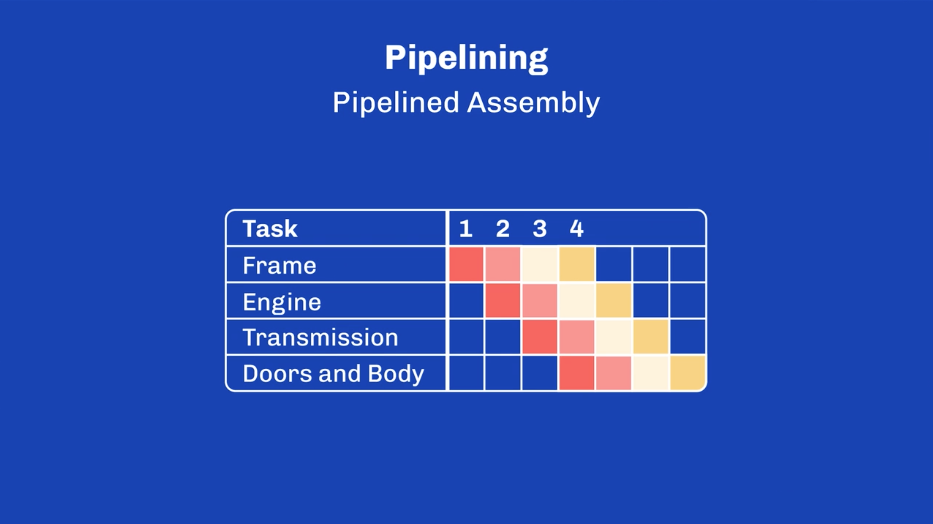Pipelining on Cardano is a technique aimed at improving the throughput and scalability of the network by optimizing the block validation process. Specifically, it allows for parts of the validation process to overlap, enabling the network to process more transactions within a given time frame, thereby increasing its throughput. This approach is critical for Cardano’s long-term scalability and efficiency goals.
In blockchain networks, block production and validation are sequential processes that require multiple steps, such as transaction selection, validation, and block propagation. Pipelining allows these steps to be processed in parallel, speeding up the overall process.
To better understand pipelining, let’s compare it with a manufacturing analogy using non-pipelined assembly versus pipelined assembly.
Non-Pipelined Assembly

In a non-pipelined assembly process, each task is completed one at a time. For example, imagine you are assembling a product with 4 steps:
- Step 1: Gather materials.
- Step 2: Assemble the product.
- Step 3: Inspect the product.
- Step 4: Package the product.
In a non-pipelined process, you complete all four steps for one product before starting the process for the next product. This means:
- Task 1 (gather materials) is fully completed for Product 1 before you move on to Task 2 (assembly).
- Once all tasks are completed for Product 1, you repeat the same process for Product 2.
- The process is sequential and takes a long time because no part of the assembly process starts until the previous step is completed.
Pipelined Assembly

In a pipelined assembly process, tasks overlap. So, while one product is being assembled, another product is being inspected, and yet another is being packaged. Here’s how it works for the same four-step process:
- Step 1: Gather materials for Product 1.
- Step 2: As soon as materials are gathered for Product 1, start assembling it while gathering materials for Product 2.
- Step 3: Inspect Product 1 while assembling Product 2 and gathering materials for Product 3.
- Step 4: Package Product 1 while other steps are happening for Products 2 and 3.
In this approach, multiple tasks are happening at the same time, but for different products. As soon as one task in the pipeline is done, the next one can begin on the same product, without waiting for the entire assembly to finish for one product before starting another. This dramatically speeds up the overall production time.
Non-Pipelined vs. Pipelined in Cardano
- Non-Pipelined Block Processing (similar to non-pipelined assembly):
- In a non-pipelined blockchain system, a block must complete the entire process before the next block can start. The steps for block processing are usually:
- A block is produced and propagated to the network.
- The network validates the block.
- Once validated, the block is added to the blockchain.
- The process repeats for the next block.
- In a non-pipelined blockchain system, a block must complete the entire process before the next block can start. The steps for block processing are usually:
- Pipelined Block Processing (similar to pipelined assembly):
- In pipelined block processing on Cardano, different steps in the block production process can happen simultaneously. For example:
- While one block is being propagated across the network, the next block is already being produced.
- While some nodes are validating a block, others are already preparing the next block.
- This overlapping of tasks allows for faster block production and higher throughput.
- In pipelined block processing on Cardano, different steps in the block production process can happen simultaneously. For example:
Benefits of Pipelining on Cardano
- Increased Throughput:
- Pipelining allows Cardano to process more transactions per second (TPS) because the network is no longer waiting for each step to complete sequentially. Multiple parts of the block validation process can occur simultaneously, increasing the overall speed of the network.
- Improved Scalability:
- As the Cardano network grows and more users and applications interact with it, pipelining will help the network scale by efficiently handling a larger number of transactions without slowing down.
- Faster Block Finality:
- Pipelining reduces the time it takes for blocks to be confirmed and added to the blockchain, which means that transactions are finalized faster. This is crucial for improving the user experience, particularly for decentralized applications (dApps) and services that require quick transaction finality.
- Reduced Latency:
- Pipelining minimizes delays between the different stages of block production and validation. This leads to lower latency, meaning transactions are processed more quickly, which enhances the overall performance of the network.
Summary
In non-pipelined assembly, each task must be completed one at a time, making the overall process slower. In pipelined assembly, tasks overlap, allowing multiple tasks to happen at the same time for different products, speeding up the process.
Similarly, in the Cardano blockchain, pipelining allows different steps of block production (such as block propagation, validation, and finalization) to occur simultaneously, increasing transaction throughput and improving scalability. This approach allows Cardano to handle more transactions per second, ensuring that the network can grow and accommodate more users and applications without slowing down.

Leave a Reply